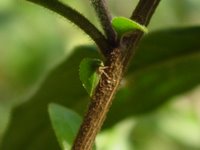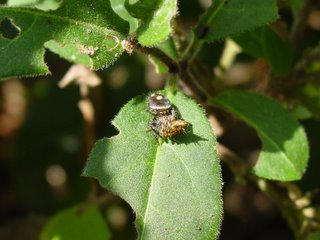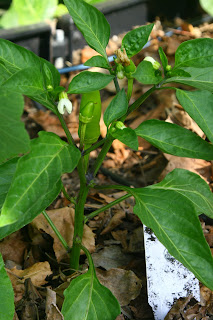Saturday, May 16, 2009
Keelback tree hopper
These guys have been in my garden for a while especially on my Cherry Tomato plant from last year. I think that I should have been more aggressive when they were in their nymph stage. The posting below from http://bugyou.blogspot.com/2005/11/treehoppers-like-tomatoes-but-whither.html has all the good info.
Treehoppers Like Tomatoes, but Whither in Winter?

These are keelbacked treehoppers, antianthe expansa. Like many of their homopteran kin (aphids, scale, whitefly) both the adults and nymphs of this species are found feeding together on the same food plant. Unlike other homopterans, the nymphs do not resemble the adults. The adult is camoflaged, looking very much like a thorn or even a young leaf. The nymphs contrast with their surroundings in shape and color. The spines serve as some protection, but what is the adaptive purpose of different morphs in the life stages? Insects with complete metamorphosis have different body forms in their developmental stages but they also have different lifestyles and food sources in each stage which their form complements and enables. This would seem to be part of an adaptive strategy to avoid being your dad and mom's own direct competition for food and shelter. Lots of homopterans including these treehoppers are tended and protected by ants; perhaps that protection has freed the nymphs to express their nymphness to the fullest.
Anyway, the first time I became aware of these bugs was when they erupted on a cherry tomato plant I had growing in a hanging basket. As is the case with other host-specific plant feeders, I had to wonder how they were able to zero in on my one tenuous tomato plant, there being (or having been) no discernable tomato-ness nearby for months and months.
A great little book I have, A Guide to Observing Insect Lives by Donald Stokes describes the egg laying and over-wintering behaviors of two other treehopper species, and also suggests there is a generalized theme applicable to all treehoppers. The eggs of the year's last generation are laid in slits in the bark of a host tree and overwinter until hatching in spring. In the case of the two-spotted treehoppers, the
 nymphs begin feeding on the tenderest shoots of the host tree until they become winged adults able to fly off in search of more tender host plants. In the case of the buffalo treehoppers, the nymphs drop off the tree after hatching and begin feeding on tender plants growing below. In both species, after several generations feeding on the tender host plants, adults return to the host trees in autumn to lay eggs. And so on.
nymphs begin feeding on the tenderest shoots of the host tree until they become winged adults able to fly off in search of more tender host plants. In the case of the buffalo treehoppers, the nymphs drop off the tree after hatching and begin feeding on tender plants growing below. In both species, after several generations feeding on the tender host plants, adults return to the host trees in autumn to lay eggs. And so on.I couldn't find any mention anywhere of the egg-laying routine of the keelbacked treehopper; but seeing as it's called a treehopper, can we assume it resembles that described above and includes a tree or tree-like appurtenance? So, in the case of the tomato-loving keelbacks, our summer plantings of tomatoes, and peppers and eggplants are the tender summer host plants the newly mobile adults are seeking in late spring. They also feed on various other plants in the tomato family (solanacea) which includes the cestrum I found them on this summer. Cestrum newelii is a tender evergreen viney shrub which could also be an ideal winter host--in our mild southern California climate it grows in spurts throughout the year but has woody stems where eggs could be laid. Note to self: Other woody solanums to check for treehopper eggs this winter in the time between writing the annual newsletter and hanging the holiday lights: potato vine (solanum jasminoides), nightshades (s. seaforthianum and wendlandii), cup of gold vine (solandra maxima), angel's trumpet (brugmansia), and even tree tobacco (nicotiana glauca).

As for treehopper control, it looks like spiders will take their share of those the ants and spines don't save. Your typical blast of water or handpicking works well. Not sure how long antianthe expansa has been here in California; maybe its parasitoid nemesis, a chalcidoid wasp by the name of anphoidea latipennis is already here or on its way north across the border.
Thanks to Peter Bryant's site for the fabulous images of treehopper nymphs and adults. No images or info on eggs could be found . . . stay tuned.
Mealy Bugs up in my garden

I have found these guys on the base of pepper plants, eggplant, carrots and especially my tomato plant that survived from last year.
http://www.mda.state.mn.us/plants/insects/plantscape/mealybugs.htm
Friday, May 15, 2009
Garden update
Planted transplants into all sections of the garden and got irrigation to entire garden. Things are looking very healthy. Pill bugs are eating sunflowers and basil. Mealy Bugs and Keaelback Tree Hopers are on the cherry tomatoes plant that survived from last year. It has had fruit since 1 month ago!
First squash are starting to grow. Last year they all rotted so I am keeping my fingers crossed this year.
First squash are starting to grow. Last year they all rotted so I am keeping my fingers crossed this year.
Zoo Doo makes my garden grow
Griffith Park composting saves city $173,000 annually - sweet!
http://www.ciwmb.ca.gov/Publications/Organics/44302020.pdf
http://www.ciwmb.ca.gov/Publications/Organics/44302020.pdf
SoCal planting guide
| Planting Period Key
|
| This table lists the recommended times to sow vegetable seeds for the typical Southern California climate (Zones 23-24). When buying transplants, remember to adjust for the age of the plant (about 1-2 months). |
 Asparagus             Beans (bush)             Beans (pole)             Beets             Broccoli             Brussel Sprouts             Cabbage             Cantaloupe             Carrots             Cauliflower             Celery             Chives             Collards             Corn             Cucumbers             Eggplant             Endive             Favas             Jicama             Kale             Kohl Rabi             Leeks             Lettuce             Lima Beans             Mustard             Okra             Onions             Parsley             Parsnip             Peas             Peppers             Potatoes             Pumpkin             Radish             Rutabaga             Spinach             Squash (summer)             Squash (winter)             Sunflowers             Swiss Chard             Tomatoes             Turnips             Watermelon             Winter Zucchini*             |
Subscribe to:
Posts (Atom)




